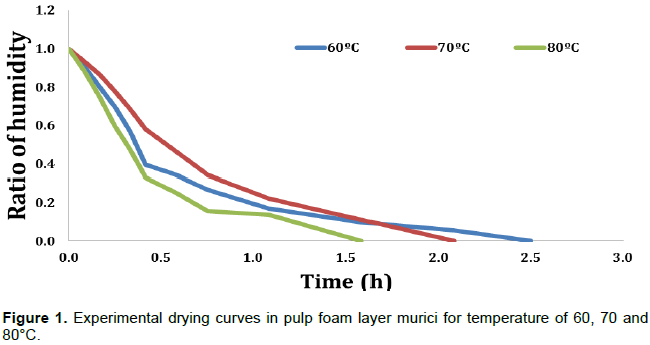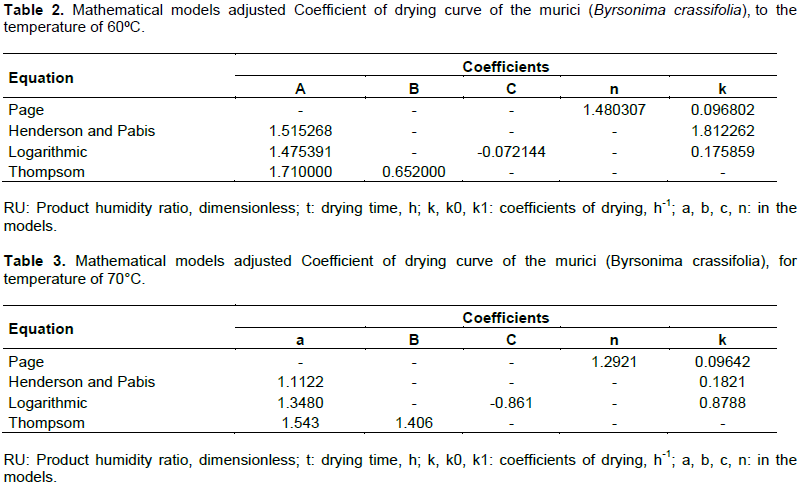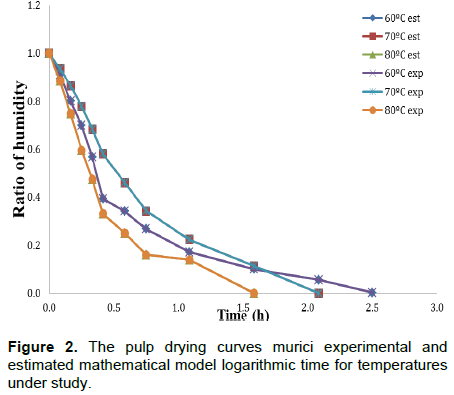ABSTRACT
The murici is a fruit of the Brazilian cerrado, with striking aroma and nutritional value. It is known that the fruit drying process for obtaining the murici dry contributes to the preservation of the product, the content of nutrients and enables your addition in formulations, emphasizing the sensory and nutritional quality of food. A drying method that has been expanding in Brazil is the method of drying foam layer, where it promotes a faster drying, being used in juices, purees and pulps. The aim of this work is to carry out the pulp drying murici per layer of foam (foam mat drying), aimed at establishing a mathematical model for your drying. The study of drying of murici in layer of foam in the conditions in which the experiment was developed, it was found that the drying temperature exerts influence on the speed of drying of the product and the mathematical model that adapted the drying conditions murici was the logarithmic.
Key words: Foam mat drying, temperature, modeling.
The muricizeiro is a shrubby plant, medium, native to the Cerrado, which can reach 5 m in height. Stem cylindrical, dark shell features, rough and narrow cup with rigid sheets and bright. The flowers are yellowish, forming clusters of 10 to 15 cm, and the seeds germinate in loamy substrate, requiring local shaded, with slow development. Its flowering begins in late August, and fruiting at the end of September. According to the incidence of rainfall, the fruit can be in mid-January or March. The harvest is done manually because of the ease of fall of ripe fruits, being that your maturation occurs in the plant and are picked when presenting yellowing, com characteristic aroma and flavour (Emater, 2010).
The murici is a fruit with a strong smell, similar to rancid cheese, typical of the Brazilian cerrado, being found from September to March, in the mountain regions of the southeast, in the Cerrado of Mato Grosso, Goiás, and in the North and Northeast of Brazil (2006). When mature, yellowish, with a diameter of 1.5 to 2 cm, each plant produces on average 15 kg of fruit per year (Emater, 2010). The pulp is fleshy and soft, and can be consumed fresh or in the form of juices, jams, ice cream, liqueurs and the dried product can be used in cereal bars (Alves and Franco, 2003). Despite all the information provided, there are few projects, involving studies on this fruit, damaging the knowledge of its physical and chemical properties, chemical and biological weapons, as well as minimize their business potential.
Drying fruit for murici dry contributes to the preservation of the product, the content of nutrients and enables addition in formulations, emphasizing the sensory and nutritional quality of food. The conservation drying mechanism is based on the fact that all the metabolic mechanism requires some amount of water for their activities. With the reduction in available water, therefore the activity of water and the speed of chemical reactions in the product, as well as the development of microorganisms will be reduced (Christensen and Kaufmann, 1974).
In recent decades, many studies have been conducted regarding the dehydration of fruit and fruit pulp (Pereira et al., 2009; Mosquera et al., 2010; Osorio et al., 2011), geared mainly to increase the retention of the nutritional and sensory properties of the product through amendments to the existing processes or application of new techniques. Among them, we highlight the foam mat drying method, which in Brazil is also called foam mat, foam bed drying or drying foam layer.
This method is widely used for drying of heat-sensitive foods. Although it has been developed to promote rapid drying of liquid food, such as juices, and has been widely used for food products such as purees and fruit pulp (Bag et al., 2011). The process consists basically of three steps: transformation of juice or pulp in stable foam through the use of additives (emulsifiers, stabilizers, thickeners); dehydration of thin-layer material till constant mass and dry mass disintegration in scales and, subsequently, powder (Furtado et al., 2010).
The aim of this work was to carry out the pulp drying murici per layer of foam (foam mat drying), aimed at establishing a mathematical model for your drying.
The fruits were harvested in production properties murici in city of Britain, Goias State. The experiments were carried out in the drying laboratory in the State University of Goiás.
For samples of the fruits, they were selected manually on the uniformity of m Stadium old-fashioned gutting it out and absence of defects. In the lab, the fruits of murici (Byrsonima crassifolia) were removed and stored in cold Chamber to 10°C during 24 h, targeting the reduction of metabolism.
The water content of the product is determined by the standard method of the greenhouse, the 105 ± 3°C for 12:00 am in three repetitions (Brasil, 2009). For foam layer drying pulp, murici, was used as a product with features sparkling, the Emustab (distilled Monoglycerides based product, sorbitana monostearate and polysorbate, 60) was added to the mass, and the pulp of Afzal was the percentages by weight of 5%. After that, all quantities were mixed in the mixer in time of 15 min, thus forming a pulp foam murici.
Pulp + emulsifier formulations were arranged in circular shaped stainless steel trays (RADIUS 150 mm and height 5 mm) and placed in an oven with forced air convection, temperature 60, 70 and 80 ± 1°C, and kept in the equipment until the dough became constant. The reduction of the water content is determined by weighing the product in digital scale (Homis, DS-2000), accurate to two decimal places, at the beginning of the drying and, later, in 1 h intervals until constant weight. The dry material was removed from the trays with the aid of plastic spatulas, showing fine granulometry, but not homogeneous.
For the calculation of the humidity ratio (RU), during the dryings in different temperatures, Equation 1 was used:
where RU is the humidity ratio, dimensionless; U is the average water content at time t,% b.s.; Ue is the water content of balance,% b.s.; and Ui is the initial water content,% b.s.
The magnitudes of the coefficient of determination (R2), the average relative error (P) and the estimated average error (SE) were used to verify the degree of fit of the models, which were calculated according to the equations:
where Y: observed experimentally;

: value estimated by the model; n: number of experimental observations; and GLM: degrees of freedom model (number of observations minus the number of parameters of the model).
Four mathematical models were adjusted for the experimental data of drying the pulp of Afzal. For the adjustment, nonlinear regression analysis was used, through the STATISTICA software (Table 1).
Drying curves
The initial humidity of the product is determined by the standard method of the greenhouse and was 22.9% b.s. Figure 1 demonstrates the behavior of the curve of the foam layer drying of pulp murici with the addition of emulsifier in the concentrations of 5%, at different temperatures. The influence that it had on the times of dryings was observed.
It was found that the time required for drying the pulp of the murici in foam layer was 2.5, 2.7 and 1.7 h to temperatures of 60, 70 and 80°C, respectively. The temperature of 80°C influenced directly on the drying time of the product 5% emustab.
Tables 2, 3 and 4, show the coefficients of each mathematical model in modeling of the pulp drying curves murici in temperatures of 60, 70 and 80°C. Table 5 shows the values of the coefficients of determination, average on errors and estimate for the four models adjusted. Among the models that performed best were the determination coefficients of logarithmic and page, agreeing with Bridges et al. (2009) in the drying of pepper. Since the logarithmic model presented for temperature of 60oC, R2=99.91, P=12.06, SE=0.01, to a temperature of 70°C, R²=99.97, P=13.41, SE=0.01 and para 80oC, R²=99.98, P=10.02, SE=0.01.
It was found that the Page templates, Logarithmic and Tompsom can meet the needs and be used to represent the drying process of the formulation with excellent precision, by coefficients of determination (R²) greater than 0.98 and SE estimated less than 0.04 reinforcing studies of Midilli et al. (2002) (Figure 2).
For the study of drying of murici in layer of foam in the conditions in which the experiment was developed, it was found that the drying temperature exerts influence on the speed of drying of the product studied, being less drying time with increasing temperature.
The mathematical model that best adapted to dry conditions was the logarithmic model, showing values of R² = 99.91, 99.97 and 99.98, for use at temperatures of 60, 70 and 80°C, respectively.
The authors have not declared any conflict of interests.
REFERENCES
|
Alves GL, Franco MRB (2003). Headspace gas chromatography–mass spectrometry of volatile compounds in murici (Byrsonima crassifolia L. Rich). J. Chromatogr. A 985(4):297-301.
Crossref
|
|
|
|
Bag SK, Srivastav PP, Mishra HN (2011). Optimization of process parameters for foaming of bael (Aegle marmelos L.) fruit pulp. Food Bioproc. Technol. 4:1450-1458.
Crossref
|
|
|
|
|
BRASIL (2009). Ministério da Agricultura Pecuária e Abastecimento. Equipe Técnica de Sementes e Mudas. Regrasparaanálises de sementes. Brasília, DF P. 398.
|
|
|
|
|
Christensen CM, Kaufmann HH (1974). Microflora. In: CHRISTENSEN, C.M. Storage of cereal grain and their products. St. Paul: American Association of Cereal Chemists pp. 158-192.
|
|
|
|
|
EMATER (2014). Empresa de Assistência Técnica e Extensão Rural. Rondônia, 2010. Disponível em:
|
|
|
|
|
Furtado GF, Silva FS, Porto AG, Santos P (2010). Secagem de polpa de ceriguela pelo método de camada de espuma. Rev. Bras. Prod. Agroind. Campina Grande 12(1):9-14.
Crossref
|
|
|
|
|
Midilli A, Kucuk H, Yapar ZA (2002). New model for single-layer drying. Dry. Technol. 20(7):1503-1513.
Crossref
|
|
|
|
|
Mosquera LH, Moraga G, Martínez-Navarrete N (2010). Mechanical changes in freeze-dried strawberry powder as affected by water activity, glass transition and carbohydrate polymers addition. J. Food Eng. P 97.
|
|
|
|
|
Osorio C, Carriazo JG, Barbosa H (2011). Thermal and structural study of guava (Psidium guajava L) powders obtained by two dehydration methods. Quím. Nova 34(4):636-640.
Crossref
|
|
|
|
|
Pereira LM, Carmello-Guerreiro SM, Hubinger MD (2009). Microscopic features, mechanical and thermal properties of osmotically dehydrated guavas. LWT-Food Sci. Technol. 42:378-384.
|
|






